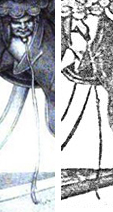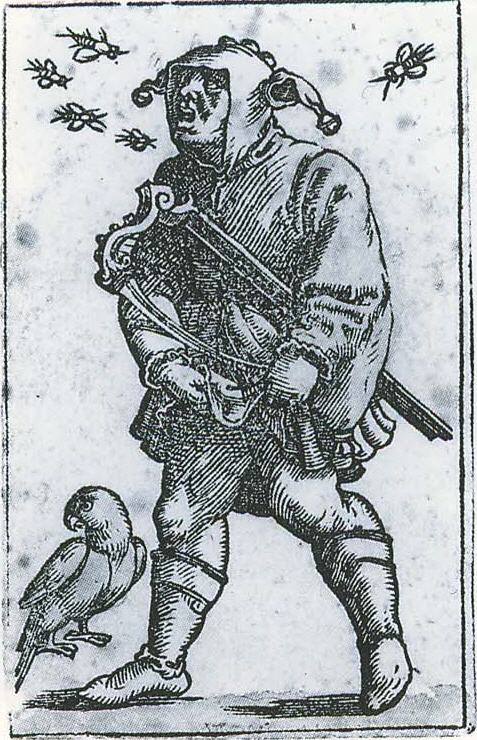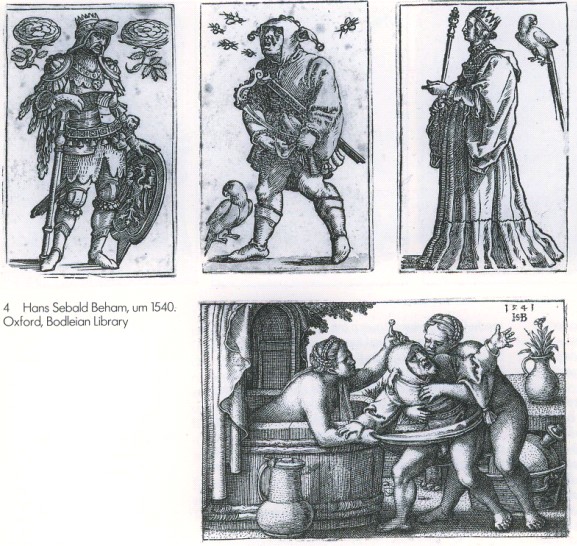Huck
In the article
"The Master of the "Sola-Busca Tarocchi" and the Rediscovery of Some Ferrarese Engravings of the 15th century"
by Mark J. Zucker
Artibus et Historiae, Vol. 18, No. 35 (1997), pp. 181-194
Published by: IRSA s.c.
http://www.jstor.org/stable/1483546?1
the author Mark J. Zucker presents various engravings, from which he assumes, that they possibly were produced by the unknown artist, who was responsible for the Sola-Busca Tarocchi ... the arguments are given on the base of stylish similarities.
Between these pictures is one, which shows a man with a "snail helmet" ....
The author Mark Zucker seems to be not aware, that another Tarocchi set exists, which also uses the "snail helmet" ... it's on the Fool card of the Leber Tarocchi. In the picture, which is assumed to be produced by the Sola Busca engraver the snail-head is at the backside and the image is a portrait, in the picture of the Leber Tarocchi the snail head is at the front and the fool is presented with full body, but the appearance is similar. The habitus of the portrait might be called "foolish" (the man has a rather extravagant nose and a putto is climbing on top of the helmet) ...
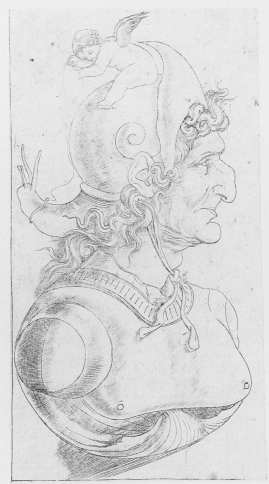
The relevant picture of the Fool of the Leber Tarocchi in a nice reproduction of Leber looked this way:
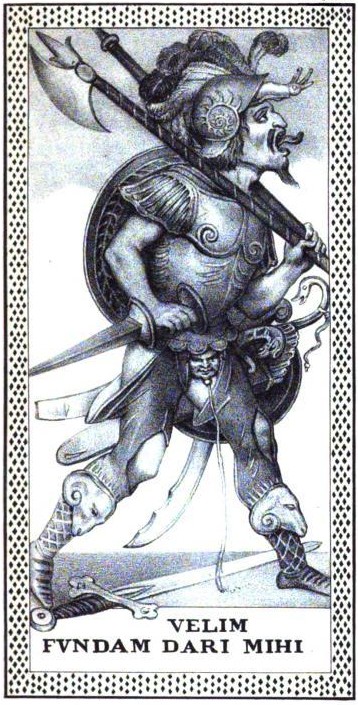
In a bad copy of the original it's this picture:

Leber's reconstruction shows not the strange "8"s, which are probably painted on the original. It's our suspicion, that these are meant to be bees. Fools with bees around them (indicating honey-stealing) are motifs for German engravers ca. 1540.
Zucker gives as Sola-Busca reference (his reason to assume an identity of the engraver) the Baton-4 (as an example) ...
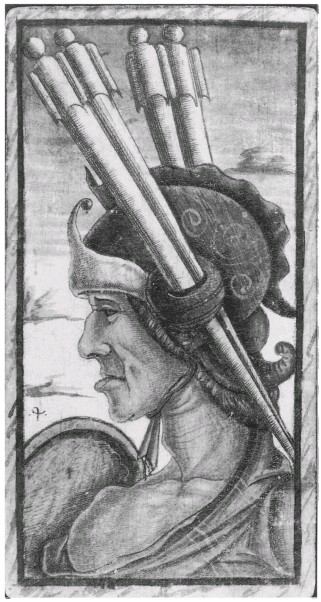
********
The detection might lead to the (plausible, but not totally secure) idea, that Sola-Busca and Leber Tarocchi were engraved by the same artist.
But ... naturally the similarity might also have the reason of a lower graded relationship: one engraver copied the other or was influenced by the other ... or a snail helmet was simply a common motif ... or it refers to a general joke, and both artists contributed in their individual design without any personal interaction between them.
In the question of the "unknown artist" Zucker mentions ...
Artist in the circle of Cosimo Tura (opinion Arthur M. Hind)
Tura's follower (opinion of Giordani Berti and Marzia Faietti)
Tura himself (Konrad Oberhuber)
Franco de' Russi (J. Byarn Shaw)
Marco Zoppo (Eberhard Ruhmer)
Zucker himself sees relationships to the "generation between Tura and Zoppo", but also to Amico Aspertini and Lodovico Mazzolino, also he mentions Peregrino da Cesena and Gianfrancesco Enzola.
In his reflections Zucker doesn't mention the year "1491" as probably production year and it's apparent, that he doesn't know about it. Also he doesn't note anything about the persons Ercole d'Este and Savonarola in the deck ... knowledge about this would have probably excluded his suggestions for the artist Gianfrancesco Enzola.
General informations to Sola Busca and Leber Tarocchi:
http://trionfi.com/0/h/51/ ... Leber Tarocchi
http://trionfi.com/0/j/d/solabusca/ ... Sola Busca Tarocchi
*****
btw. the strange inscription "Velim Fundam Dari Mihi", translated by Ross with "I wish the purse to be given to me", might explain, that the card of the fool was connected to "luck in the game" or to lucky points, which in their final consequence had the result, that the player with Fool card had higher chances in the game (as it appears in rules, which are known only from later times).
btw. "snails" are considered to present "wisdom", at least at the Sebaldusgrab in Nurremberg, relatively contemporary, but at another location.
Perhaps we have to interprete, that the snails below the helmet are considered to present "leaving snails", as Fools are left by wisdom.
"The Master of the "Sola-Busca Tarocchi" and the Rediscovery of Some Ferrarese Engravings of the 15th century"
by Mark J. Zucker
Artibus et Historiae, Vol. 18, No. 35 (1997), pp. 181-194
Published by: IRSA s.c.
http://www.jstor.org/stable/1483546?1
the author Mark J. Zucker presents various engravings, from which he assumes, that they possibly were produced by the unknown artist, who was responsible for the Sola-Busca Tarocchi ... the arguments are given on the base of stylish similarities.
Between these pictures is one, which shows a man with a "snail helmet" ....
The author Mark Zucker seems to be not aware, that another Tarocchi set exists, which also uses the "snail helmet" ... it's on the Fool card of the Leber Tarocchi. In the picture, which is assumed to be produced by the Sola Busca engraver the snail-head is at the backside and the image is a portrait, in the picture of the Leber Tarocchi the snail head is at the front and the fool is presented with full body, but the appearance is similar. The habitus of the portrait might be called "foolish" (the man has a rather extravagant nose and a putto is climbing on top of the helmet) ...

The relevant picture of the Fool of the Leber Tarocchi in a nice reproduction of Leber looked this way:

In a bad copy of the original it's this picture:

Leber's reconstruction shows not the strange "8"s, which are probably painted on the original. It's our suspicion, that these are meant to be bees. Fools with bees around them (indicating honey-stealing) are motifs for German engravers ca. 1540.
Zucker gives as Sola-Busca reference (his reason to assume an identity of the engraver) the Baton-4 (as an example) ...

********
The detection might lead to the (plausible, but not totally secure) idea, that Sola-Busca and Leber Tarocchi were engraved by the same artist.
But ... naturally the similarity might also have the reason of a lower graded relationship: one engraver copied the other or was influenced by the other ... or a snail helmet was simply a common motif ... or it refers to a general joke, and both artists contributed in their individual design without any personal interaction between them.
In the question of the "unknown artist" Zucker mentions ...
Artist in the circle of Cosimo Tura (opinion Arthur M. Hind)
Tura's follower (opinion of Giordani Berti and Marzia Faietti)
Tura himself (Konrad Oberhuber)
Franco de' Russi (J. Byarn Shaw)
Marco Zoppo (Eberhard Ruhmer)
Zucker himself sees relationships to the "generation between Tura and Zoppo", but also to Amico Aspertini and Lodovico Mazzolino, also he mentions Peregrino da Cesena and Gianfrancesco Enzola.
In his reflections Zucker doesn't mention the year "1491" as probably production year and it's apparent, that he doesn't know about it. Also he doesn't note anything about the persons Ercole d'Este and Savonarola in the deck ... knowledge about this would have probably excluded his suggestions for the artist Gianfrancesco Enzola.
General informations to Sola Busca and Leber Tarocchi:
http://trionfi.com/0/h/51/ ... Leber Tarocchi
http://trionfi.com/0/j/d/solabusca/ ... Sola Busca Tarocchi
*****
btw. the strange inscription "Velim Fundam Dari Mihi", translated by Ross with "I wish the purse to be given to me", might explain, that the card of the fool was connected to "luck in the game" or to lucky points, which in their final consequence had the result, that the player with Fool card had higher chances in the game (as it appears in rules, which are known only from later times).
btw. "snails" are considered to present "wisdom", at least at the Sebaldusgrab in Nurremberg, relatively contemporary, but at another location.
Perhaps we have to interprete, that the snails below the helmet are considered to present "leaving snails", as Fools are left by wisdom.

